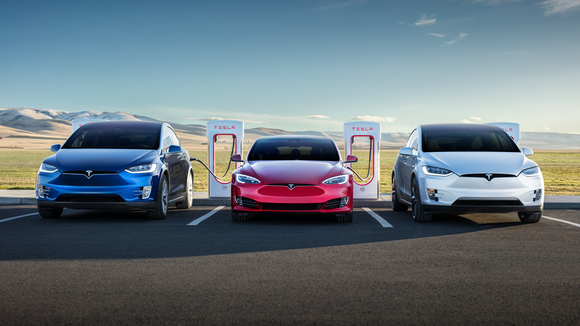Tesla Wants To Be The World's Best Manufacturer

This article originally appeared in the Motley Fool.
A few years ago, electric-car company Tesla (NASDAQ:TSLA) realized it was time to reprioritize much of its engineering talent away from product design and toward manufacturing. "Tesla is going to be hell-bent on becoming the best manufacturer on earth," said Tesla CEO Elon Musk during the company's first-quarter earnings call in 2016.
The shift in strategy was arguably out of necessity. With plans to launch its Model 3 in 2017, the company was about to embark on a quest to increase its annual production fivefold in just a few years' time. But after two delays for its Model 3 production targets, things aren't going as planned. Tesla knew the initial phases of ramping up manufacturing of its first high-volume vehicle would be "production hell," but after its worse-than-expected start, Musk admitted Tesla was in "a deeper level of hell than we expected."
Despite its initial challenges in becoming a high-volume automaker, Musk said in the most recent earnings call that he thinks Tesla is "swiftly exiting" hell. Furthermore, it's still betting it will be the world's best automotive manufacturer.
Becoming The Best
In its recently released fourth-quarter shareholder letter, Tesla's bold manufacturing aspirations were in full swing:
Our goal is to become the best manufacturer in the automotive industry, and having cutting edge robotic expertise in-house is at the core of that goal. Our recent acquisitions of advanced automation companies have added to our talent base and are helping us increase Model 3 production rates more effectively.
During the quarter's earnings call, Musk expounded on why he believes there's room to significantly improve automotive manufacturing.
"And what I find sort of interesting is that our competitors -- well, the car industry thinks they're really good at manufacturing. And they're actually -- they are quite good at manufacturing," he noted, "but they just don't realize just how much potential there is for improvement."
The most productive automotive manufacturing lines in the world are currently producing one vehicle about every 25 seconds, Musk said. But another way to think of this, he pointed out, is that the production line is moving at a speed of just 0.2 meters per second. "Grandma with a walker can beat the speed of the fastest production line on earth," he explained. "So really not that fast. Walking speed is 1 meter per second, so 5x faster than the fastest production line on earth."
The Long Game
Interestingly, part of Tesla's focus on not just increasing vehicle production but also on becoming the world's best automotive manufacturer could be what's behind the automaker's near-term production headwinds. On the flip side, however, it could also be what ultimately helps it achieve uncanny production rates further down the road.
"We don't want to simply replicate what we have built previously while designing additional capacity," Tesla explained in its fourth-quarter shareholder letter. "We want to continuously push the boundaries of mass manufacturing."
Tesla's long-term thinking in manufacturing was evident during the fourth-quarter earnings call, when Musk referred to "productizing" its factory.
We're going to productize the factory. And really this is the lesson that is kind of obvious in history because the Model T wasn't a product. It was River Rouge. The Model T is a very simple car. Anybody could have made that car, but not anyone could make River Rouge.
Taking on such an ambitious vision for its manufacturing likely requires outsize engineering efforts compared to an alternative scenario in which Tesla focused primarily on hitting near-term production targets.
By pushing the boundaries of manufacturing, Musk believes manufacturing will be Tesla's competitive advantage. "We'll have a great lineup of great products, great design, great engineering the product itself in the vehicles and autonomy and all that sort of stuff," he said. "But the factory is going to be the product that has the long-term sustained competitive advantage, in my opinion."
Model 3 production targets undoubtedly imply extraordinary manufacturing. After just building 2,425 Model 3s in its fourth quarter, management says it can achieve a weekly production rate for Model 3 of 2,500 units by the end of Q1 and 5,000 units by the end of Q2. After these targets are achieved, Tesla says it will then begin adding the capacity to get to a weekly rate of 10,000 Model 3s per week.
In theory, it all sounds great.
A Word Of Caution
Of course, Tesla investors can't take Musk at his word yet. The electric-car maker is far from the manufacturing behemoth it wants to be, producing just over 100,000 vehicles in 2017. Sure, its vehicle production has climbed quickly from just several thousand vehicles per year in 2012. But Musk will have to prove it can at least match speeds of the fastest production lines before investors start believing Tesla can venture into uncharted territory.
For now, Tesla's astronomical manufacturing ambitions should be viewed as nothing more than speculation. If it begins to surprise investors with better-than-expected production, that's when they may want to start giving some weight to this big vision for manufacturing.
Maybe this is a long game that will pay off. Investors, however, simply can't bet on it yet.

Daniel Sparks owns shares of Tesla. The Motley Fool owns shares of and recommends Tesla. The Motley Fool has a disclosure policy.





















